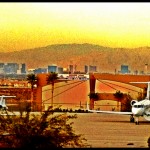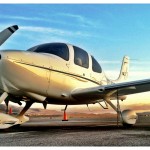Welcome to 2012, the year it’s all supposed to end. Everyone likes to joke about the Mayan calendar, but perhaps they simply knew the election cycle would be tedious enough to make the entire planet take the Jonestown route.
The turning of another page on the calendar reminds us of the passage of time. Or at least, it would if anyone had a calendar with physical pages to turn. For most it’s now done with the click of a mouse or flick of the finger on the iPhone. Even that is becoming passé — now you can simply talk to Siri and have her handle the scheduling for you.

I wonder how long it will be before we can say things like, “Siri, load the ILS 19 approach and fly it for me. After we land, please taxi to Atlantic and have them add 16,000 pounds of fuel. Oh, and order ‘the usual’ for me with the caterers, will you?”
The past twelve months has seen some changes for me in the flying department. Last month I flew my final flight in the U-21A for Dynamic Aviation and got the ceremonial hose-down by the Los Alamitos JFTB fire department.
A fellow pilot captured part of the event on a solid-state video camera he’d won at the company Christmas party the night before. He apologized profusely for the quality, but I’m just happy to have a memory of my final day there.
Over the course of four years I logged 2,000 hours of time in those old Vietnam birds, upgraded to captain, and flew as a training captain to help the up-and-coming PICs get comfortable with the left seat.
I won’t miss cleaning out augers, flying at the top of the inversion layer on a 105 degree day with hot air from the compressor being exhausted into the cockpit, or taking off and landing at the same airport all the time. But there are certainly some things I’ll miss about the job. The people, for one. Though many of them were low-time when they’d arrive at CMF, that didn’t matter. I always admired the positive attitude, strong work ethic, and good humor they’d display. It was inspiring to watch them learn and grow.
The aircraft were pretty bare-bones, lacking even a simple autopilot. So the whole 2,000 hours were hand-flown with a great degree of precision (measured in feet!) in high-density airspace, often at low altitude, very close to terrain, and it places that one would not normally be allowed to fly at all, let alone VFR.

True story: I was flying back to Orange County from Napa in an SR-22 a couple of years ago and drank a huge cup of iced tea en route. By the time I reached southern California, I really needed to get to the bathroom. As I approached Van Nuys, I asked the controller if I could take a shortcut through the LA Class Bravo airspace and go direct to SNA.
At first the controller flatly denied me, saying “you can’t just do whatever you want around here, you have to fly one of the published transition routes or go around the airspace!”. After a moment’s thought, I keyed the mike and said, “Would it make any difference if I said I was a Medfly pilot?”. He replied, “Oh, you fly for Medfly?? Cleared through the bravo airspace, proceed direct John Wayne Airport.” As they say, membership has its privileges.
At Medfly, there were times when we’d literally be in a loose formation with A380s on final for LAX. Down at 500′ mixing it up with helicopters. Dodging skydivers (or as we called them, meat-bombs) around Lake Elsinore. Zipping up and down the Cajon pass while turbulence beat us to hell and back. Making 60 degree bank turns and reversing course while rolling out within 10 feet of the center of the next course line. My accuracy wasn’t always that good, but I somehow convinced myself to take credit for it when it was.
Of course, the big event for me in 2011 was moving into the Gulfstream IV. After spending the better part of a month in Dallas this past summer obtaining my type rating, I’ve had a few months to get used to the real-world aspect of flying this airplane and learning how much I still have to learn.

The G-IV is a fairly complex piece of machinery and there are all sorts of quirks, tips, flows, rules-of-thumb, and procedures you don’t get taught in school. Thankfully I’ve been flying with some highly experienced pilots who have been passing that stuff along. As the “new guy”, you want to ask questions, but not so many that you become annoying. My 6+ years as an instructor taught me that you can learn an awful lot by watching, so I do that as much as possible.
I’m also new to international flying, and have made several Atlantic and Pacific crossings. None of this stuff is hard, but details are important in this job and there are plenty of them. Miss just one and you can find yourself in a pickle. Example: I flew a pair of Hawaii trips over the new year, and somehow managed to airline out to Kona without taking the black pants which are a rather vital part of my uniform. Small detail, but kind of an important one. On the plus side, I learned something new: the Macy’s in Kona stays open until 9 pm on New Year’s eve.
In the room-for-improvement category, landing the Gulfstream is still a bit hit-and-miss for me. Oh, the landings are all perfectly safe. But when there are passengers on board, pilots pride themselves in providing the smoothest ride possible, and the landing is one of the last things they experience.

Swept-wing jets are a little different than other aircraft in that regard. For one thing, with the radar altimeter, judging one’s altitude above the ground is a non-event. The aircraft verbally counts down your altitude from 50′ AGL in 10 foot increments. But once the mains are down, the nose must also be flared for landing, lest it come crashing down with enough force to make you wonder if that’s how the nutcracker got it’s name. Getting it just right takes a bit of finesse.
Some Gulfstream IVs have the galley right behind the cockpit, while others have it in the aft portion of the pressure vessel. That location seems to affect the physical input necessary for a proper secondary flare. Also, you don’t want to waste so much time trying to finesse the touchdown that you land outside the touchdown zone. This is a larger airplane and it will eat up runway quickly if you let it float endlessly seeking that feather-smooth touchdown.
I also worry because the nosegear is only locked a fraction of an inch over center. I’m sure it’s more than sufficient for the job, but it’s one of those tidbits from ground school which I wrote in my notebook with a big exclamation mark next to it. Everything on these jets costs big money. The brakes alone cost tens of thousands of dollars to replace. Each.
My writing is probably far less interesting to many of you than the photos I post, so I’ll conclude by offering up a few photographic highlights from the year. Thanks for being part of the journey, and may 2012 bring happiness and good health to both us and this crazy industry of ours!





















I was just wondering who would be around when I fly 3 days at Medfly at the end of the month. I’ll miss seeing you around there.
Sorry I won’t be around to say hello! I might stop by some time to poke my head in if I’m around the Los Al area. If I don’t see you, say hello to everyone for me! Safe flying…
You sure know how to perk one’s interest with a picture of armed guards around your airplane. Stay safe on the ground too!
Will do. Good to hear from you, Ben! Hope things are going well for you with your own flying!